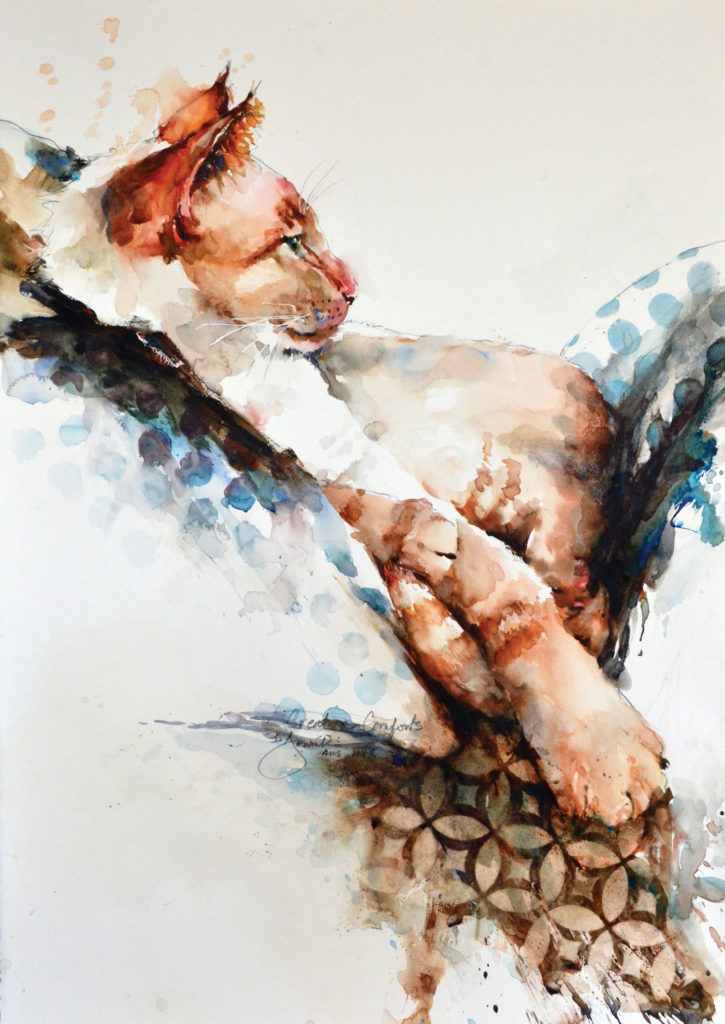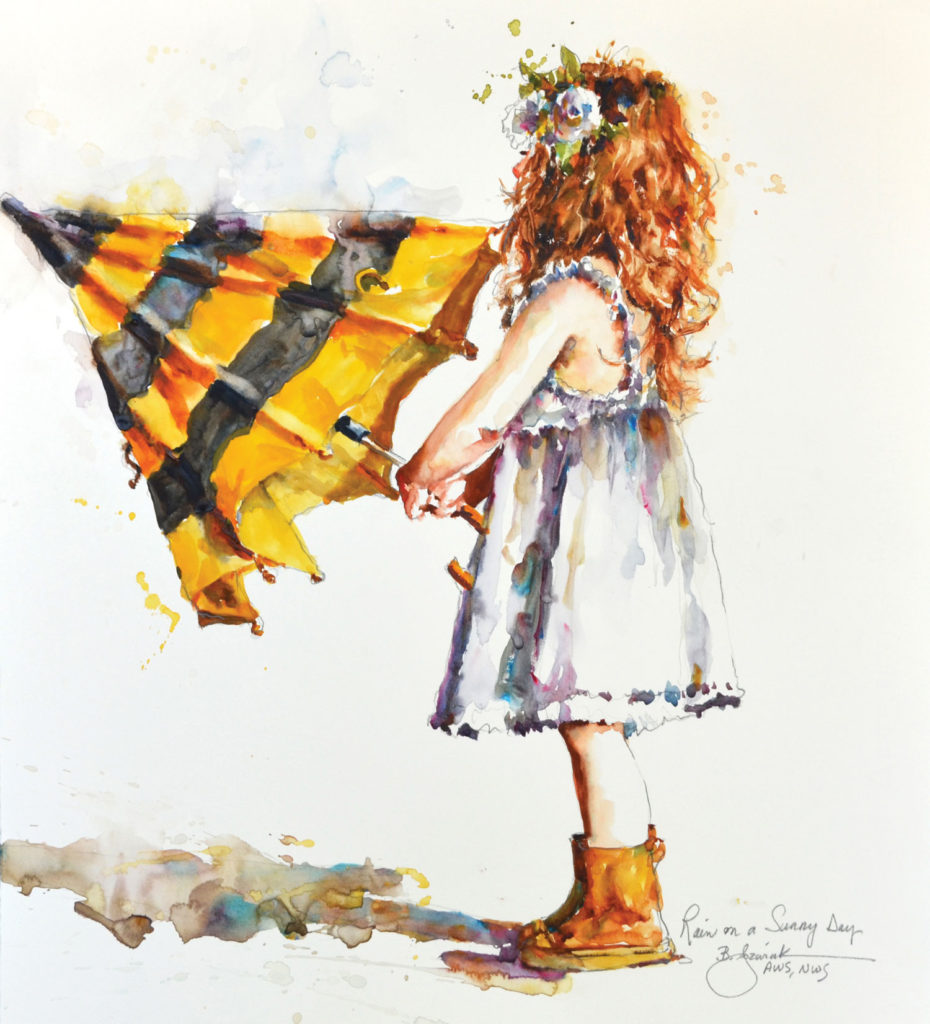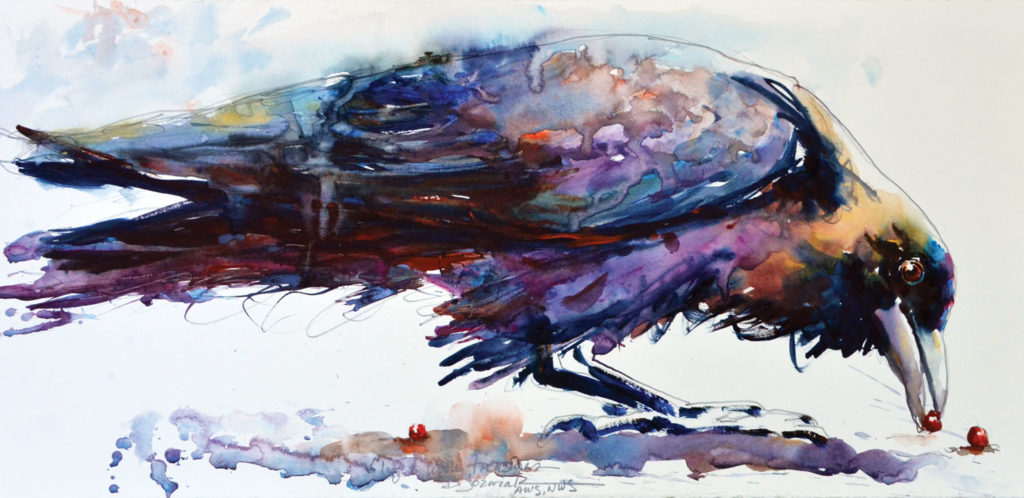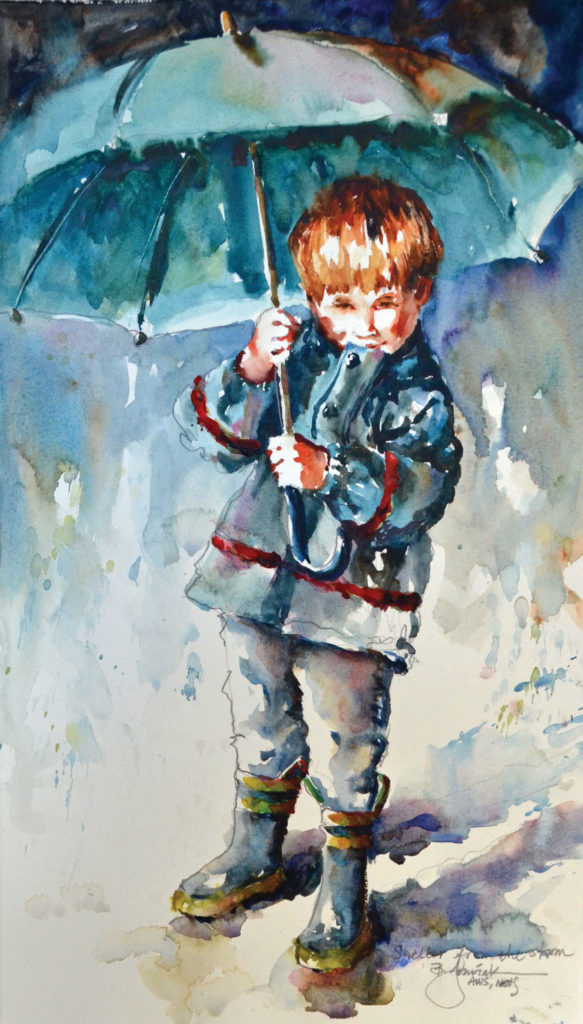Get Loose! 7 Steps to Painterly Watercolors

Think Different, Paint Different
Painting loose can appear effortless, but it actually requires a shift not only in process but also in thinking. However, once you learn to literally “let loose,” relax and embrace the process, the results are powerful, freeing and have an almost effortless painterly quality. Ready to try loosening up your painting approach? Below, award-winning watercolor artist Bev Jozwiak shares seven tried-and-true tips for achieving a more relaxed painting style.
Sponsored by

1. Draw a Strong Foundation
We’ve been taught from a young age to stay inside the lines in our artwork, and it’s difficult to break that habit,” says Jozwiak. “But, I’ve learned over time that it’s possible to ‘draw tight and paint loose.'” She continues, “I find that it’s important to establish a strong foundation for my paintings, so I draw with much more detail than I paint. This enables me to paint with complexity where I want and ‘slop’ paint outside those lines as I choose.” If you find it difficult to break outside the lines, try erasing a few key pencil marks. Doing so will help you remember that you don’t just want to fill in the spaces.

2. Think of Your Painting as a Whole
Approaching your painting as a whole, and not as a foreground and a background, will help you to loosen up. If you choose not to paint a background — or to keep it almost white — the object should fade into the background naturally. If you do choose to use a background, then it’s important to find ways to drag your background into your subject. Always think about lost and found edges, or hard and soft edges. Jozwiak says, “When teaching, I tell my students that I’m open to all questions, except one: ‘What do I do with the background?’ Once they’ve finished their subject, I can’t provide an answer. It will look like an afterthought, because, quite frankly, it is.”

3. Use a Confident Brushstroke
A confident brushstroke lends itself to a more relaxed painting. “When we’re first learning to paint,” Jozwiak explains, “we’re often focused on how to mix colors and make our paintings look representational, which can appear a bit fussy and muddled. As we grow in our technique and experience, the concepts become more complex. We begin thinking about design (the weaving of darks and lights through our piece), color dominance and temperature, values, unity, and so much more.” Leave some white paper showing, or try to weave lights and darks throughout your painting to create a more compelling design. A well-placed, deliberate stroke can do more for a painting than lots of little hesitant ones. This type of stroke comes only with a plethora of paintings under your belt.

4. Choose the Proper Painting Supplies
“Choosing the right materials can make a big difference in how loose and painterly your painting turns out,” the artist says. “I like to paint on slick surfaces, usually opting for 140-lb. hot-pressed Stonehenge Aqua by Legion. I’ll occasionally paint on YUPO, cold-pressed or rough paper. A slicker surface provides less ‘grip’ for paint and allows a more natural flow.”
You can’t use the same brush on the various papers and expect the same results. Jozwiak’s go-to brush is Cheap Joe’s Golden Fleece No. 10 round. “It’s the brush I use on YUPO or hot-pressed paper,” she continues. “It’s an inexpensive brush with a great point that I abuse horribly by painting, scrubbing and even pushing paint backward for a textured look, and yet it survives. In addition, it holds just the right amount of water for these slick papers.” When painting on cold-pressed or rough paper, Jozwiak notes she uses a mop brush or a sable, as each holds more water and allows for a more fluid stroke. It’s a good idea to experiment with a variety of brushes on different papers to determine the outcomes you most desire in your work.

5. Start With Thick Paint
Although it seems counterintuitive, “I’ve found that applying heavy, almost toothpaste-consistency paint directly onto the paper allows me to paint looser,” Jozwiak says. “With that much paint on the surface, it’s then possible to just hit it with water and let the thick paint run.” She adds, “I actually mix very little paint on my palette, but when I do, I drag in new color before applying it to the paper. Using a thicker paint ensures that I avoid homogenizing or stirring the paint too much.” Check your palette regularly as you work, ensuring that you haven’t stirred it into a lifeless puddle. If it’s not pretty on the palette, it’s not going to be pretty on the paper.

6. Don’t “Finish” Your Painting
When using a loose painterly style, Jozwiak opts not to finish out every inch of a painting. “I’ve learned over time that it’s OK to leave parts of a painting unfinished or faded,” she explains. “The viewer will ‘fill in the blanks.'” When you’re painting, determine which areas aren’t as important to the painting’s story. It’s often the background and lower portions of the painting. When painting figures, it’s often the forehead, sides of the face and limbs.

7. Loosen Up Your Mind and Body
Your brush is an extension of your mind and body. If you’re feeling tense, it will come through in your work, often resulting in a fussy, overdone painting. Just as you’d prep your palette before painting, it’s important to prep yourself. Do some stretches or neck rolls to release any pent-up tension. Listen to music that inspires you, and take breaks as needed. A loose, more relaxed painting style develops over time through lots of practice — and patience. Embrace the process and enjoy this video to inspire you to more loose and free interpretations of your next artistic creation!
Watercolor Portrait Demo, Step by Step
Here Bev Jozwiak breaks down her process for creating a portrait using a loose and painterly style.
Step 1
Jozwiak used a No. 2 pencil to sketch a preliminary drawing on hot-pressed paper, thinking in terms of shapes, not objects. This means that she drew the shadows and the shapes, not the nose, mouth and eyes. To create the eyes, she painted the entire eye sockets, including painting right over the whites of the eyes.

Step 2
Continuing with the idea of painting shapes, Jozwiak filled in more of the face. The darkest skin tones are a mixture of French ultramarine blue, burnt sienna and cadmium red. As she moved into the lighter side of the face, she frequently used a mixture of cadmium red and yellow ochre. The blue by the temple is Holbein lavender.

Step 3
To keep things loose and painterly, Jozwiak painted directly on the paper using an almost toothpaste-like consistency of paint, and then hit the thick paint with water. Using a dry brush in a calligraphic manner in some areas, and splashes of water in others, helped the painting look alive. She determined areas in which she could lose edges, such as those around the hat and the shadow portions of the face. Lost edges can happen in white-into-white areas or dark-into-dark ones.

Step 4
Warm colors pull objects forward, while cool colors cause them to recede. With this in mind, Jozwiak placed warm colors on the nose and cheeks.

Final Step
Jozwiak added small details to the lips and eyes, and a few other areas, to complete Come in From the Cold (watercolor on paper, 16 x 14).

Try This at Home
Create a painting using Jozwiak’s tips for achieving a loose, painterly style. Then, follow and tag us @artistsnetwork on Instagram. We would love to see all your painterly creations. And, if you have any watercolor tips for painting loose, share them with us in the comments. Happy painting, artists! Sponsored by
Making paper is an art. Since our 1994 inception, we have played a pioneering role in the world of fine art paper. We travel the globe on a never-ending search for the finest papers. And we listen to the needs of our clients and seek out new ways for them to enhance their work. We put vision into paper. We are paper.






I found this article very enlightening. I have been painting for almost 5 years now. I know it is time for me to let loose. Thanks for all great the tips. I will go through them 1 by 1 and share this article with my painting friends.
Hello Watercolor Artist Magazine, I like the number 7 in the article, because I too, when painting, I will get a piece of jazz music that I love most, then the spirit of the new artist living up to dismiss the anxiety, the angered in life, a painter when drawing like a monk, so loosen his mind out from that picture of ourselves we will have feelings in depth.I also have My oil paintings in vietnam we hope you can visit. Thank you very much for your article